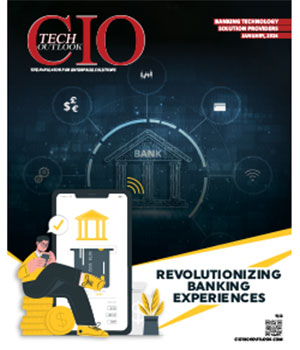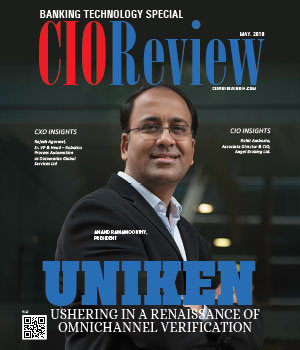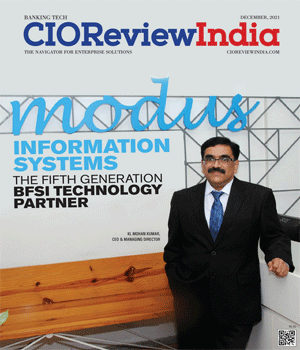
Biometric Authentication in Banking: The Future of Secure Transactions
V. Vaidyanathan, Co-founder and CEO, Rainmakerz | Saturday, 18 January 2025, 05:52 IST
 V. Vaidyanathan is a seasoned professional with over three decades of expertise in banking, technology, consulting, digital transformation, and business management. As the co-founder and CEO of Rainmakerz, he leads a consulting firm that serves banks and financial institutions across India and the Asia Pacific region. Before this, he was the Chief Information Officer at Unity Small Finance Bank Ltd.
V. Vaidyanathan is a seasoned professional with over three decades of expertise in banking, technology, consulting, digital transformation, and business management. As the co-founder and CEO of Rainmakerz, he leads a consulting firm that serves banks and financial institutions across India and the Asia Pacific region. Before this, he was the Chief Information Officer at Unity Small Finance Bank Ltd.
The financial industry is a cornerstone of modern economies; facilitating trillions of dollars in transactions daily. At the heart of this system lies the need for robust authentication mechanisms to ensure secure interactions between individuals, businesses, and financial institutions. As digitalization reshapes banking, the future of authentication must evolve to address emerging threats while meeting user demands for convenience and efficiency. Let us delve into the evolution of authentication in banking, explore cutting-edge innovations, and examine the future of secure transactions.
The Evolution of Authentication in Banking
Historically, banking authentication relied on simple mechanisms such as personal identification numbers (PINs) and passwords. These methods were sufficient in an era where physical presence at a bank was required for most transactions. However, the rise of online banking and mobile platforms exposed the limitations of traditional methods, including susceptibility to phishing attacks, password breaches, and social engineering tactics.
In response, financial institutions began adopting two-factor authentication (2FA). This approach added a layer of security by requiring users to provide two types of credentials: something they know (e.g.,a password) and something they have (e.g.,a one-time password sent via SMS).While 2FA significantly enhanced security, it introduced new vulnerabilities. For instance, SMS-based authentication could be compromised through SIM swapping or interception.
Biometric authentication, including fingerprint scans, facial recognition, and voice recognition, emerged as a game-changer. These methods leverage unique physiological or behavioural traits, offering both security and user convenience. Yet, even biometrics have limitations, such as spoofing or the irrevocability of biometric data if compromised.
Current Trends in Banking Authentication
As cyber threats grow more sophisticated, the banking industry is exploring innovative authentication technologies. Key trends shaping the present landscape include:
1. Multi-Factor Authentication (MFA) Beyond 2FA
Modern MFA systems combine multiple layers of verification, such as biometrics, geolocation data, and device recognition. For example, if a transaction request originates from an unfamiliar device or location, additional verification steps are triggered to confirm the user’s identity.
2. Behavioural Biometrics
Behavioural biometrics analyse patterns such as typing speed, mouse movements, and touchscreen interactions to verify a user’s identity. Unlike traditional biometrics, behavioural traits are difficult to replicate, making this method a robust defence against fraud.
3. Passwordless Authentication
Password less systems eliminate the need for traditional passwords, replacing them with alternatives like biometric scans, crypto graphic keys, or email-based login links. This approach reduces the risk of credential theft and improves user experience.
4. Decentralized Identity Systems
Decentralized identity systems leverage block chain technology to give users control over their digital identities. Instead of storing authentication data in centralized databases, which are prime targets for hackers, decentralized systems distribute this information across secure networks.
5. Artificial Intelligence (AI) and Machine Learning (ML)
AI and ML are transforming authentication by enabling real-time risk assessment. These technologies analyse vast data sets to detect anomalies, such as unusual transaction patterns,and trigger additional security measures when needed.
Challenges in Implementing Advanced Authentication
While innovative technologies promise enhanced security, their adoption comes with challenges:
1. Balancing Security and Usability
Financial institutions must strike a delicate balance between robust security and user convenience. Overly complex authentication processes can frustrate users, leading to customer attrition.
2. Cost and Infrastructure
Implementing advanced authentication systems requires significant investment in technology and infrastructure.Smaller banks and credit unions may struggle to keep pace with larger institutions.
3. Privacy Concerns
Biometric and behavioural data collection raises privacy concerns among consumers. Financial institutions must ensure compliance with data protection regulations, such as GDPR and CCPA, while addressing public apprehensions.
4. Seamless Integration
As banks adopt diverse authentication methods, ensuring seamless integration across platforms and systems becomes a challenge. Interoperability is crucial for providing a consistent user experience.
The Future of Authentication in Banking
The future of banking authentication lies in technologies that prioritize security, convenience, and adaptability. Emerging trends and innovations set to redefine secure transactions include:
1. Biometric Advancements
Biometric authentication will evolve to include more sophisticated methods, such as iris scans, vein pattern recognition, and heartbeat monitoring. These techniques offer higher accuracy and resistance to spoofing compared to current biometrics.
2. Continuous Authentication
Continuous authentication monitors user behaviour through out a session, rather than relying on a single login event. By analysing patterns such as browsing habits and device usage, this approach ensures ongoing verification without disrupting the user experience.
3. Zero-Trust Architecture
Zero-trust architecture assumes that no user or device should be trusted by default, even within an organization’s network.This model requires continuous verification of identity and access privileges, reducing the risk of insider threats and unauthorized access.
4. Quantum-Resistant Authentication
As quantum computing advances, it poses a threat to traditional crypto graphic methods. Banks will adopt quantum-resistant algorithms to secure authentication processes against future quantum- based attacks.
5. Voice and Emotion Recognition
Voice authentication will become more nuanced with the integration of emotion recognition. By analysing vocal tone and sentiment, banks can identify potential fraudsters or distressed customers in real time.
6. Integration of Wearable Technology
Wearable devices, such as smartwatches and fitness trackers, will play a more significant role in authentication.These devices can provide additional verification through metrics like heart rate or movement patterns.
7. Identity-as-a-Service(IDaaS)
IdaaS platforms will enable banks to outsource authentication to specialized providers, reducing costs and ensuring access to the latest security technologies. These platforms will also facilitate interoperability across financial ecosystems.
Case Studies: Leading the Way in Authentication
Several financial institutions a real ready pioneering advanced authentication technologies:
- HSBC: HSBC has integrated voice biometrics in to its customer service system, allowing users to authenticate their identity simply by speaking. The system has reportedly prevented millions of dollars in fraud.
- JPMorganChase: The bank employs AI-powered fraud detection systems that analyse transaction patterns and flag suspicious activities for additional authentication.
- BBVA: BBVA uses behavioural biometrics to enhance security on its mobile banking app, providing a frictionless yet secure user experience.
Conclusion
Authentication in banking is at a transformative juncture, driven by the dual imperatives of combating cyber threats and enhancing user convenience. The future of secure transactions will be defined by technologies that blend biometric precision, AI-driven intelligence, and decentralized identity frameworks. However, the journey toward this future demands careful navigation of challenges, including cost, privacy, and interoperability.
As financial institutions embrace these innovations, collaboration with technology providers, regulators, and consumers will be essential. By fostering trust and prioritizing security,the banking industry can build a resilient authentication framework that safeguards transactions in an increasingly digital world. Ultimately, the future of authentication lies not just in protectingassets but in empowering users with seamless, secure, and intuitive banking experiences.
CIO Viewpoint
Gen AI: Transforming Cloud Solutions for...
By Matt Yanchyshyn, VP - AWS Marketplace & Partner Services, AWS
Upcoming Technological Advancements in Payments...
By Pinak Chakraborty, CIO of Airtel Payments Bank
Shaping the Future of AI: Talent, Innovation,...
By Yann LeCun, Chief AI Scientist at Meta
CXO Insights
Crafting the Digital Journey in Banking
By Janifha Evangeline
Incorporating Blockchain Capabilities into...




.jpg)
.jpg)





